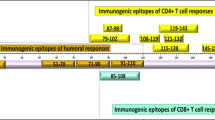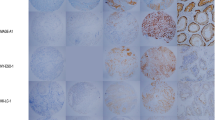Abstract
Background
Based on their tumor-associated expression pattern, cancer/testis antigens (CTAs) are considered potential targets for cancer immunotherapy. We aim to evaluate the expression of CTAs in non-Hodgkin’s lymphoma (NHL) samples and the ability of these patients to elicit spontaneous humoral immune response against CTAs.
Methods
Expression of MAGE-A family, CT7/MAGE-C1, CT10/MAGE-C2, GAGE and NY-ESO-1 was analyzed by immunohistochemistry in a tissue microarray generated from 106 NHL archival cases. The humoral response against 19 CTAs was tested in 97 untreated NHL serum samples using ELISA technique.
Results
11.3 % of NHL tumor samples expressed at least 1 CTA. MAGE-A family (6.6 %), GAGE (5.7 %) and NY-ESO-1(4.7 %) were the most frequently expressed antigens. We found no statistically significant correlation between CTA positivity and clinical parameters such as NHL histological subtype, Ann Arbor stage, international prognostic index score, response to treatment and overall survival. Humoral response against at least 1 CTA was observed in 16.5 % of NHL serum samples. However, overall seroreactivity was low, and strong titers (>1:1000) were observed in only two diffuse large B-cell lymphomas patients against CT45.
Conclusion
Our findings are in agreement with most of published studies in this field to date and suggest an overall low expression of CTAs in NHL patients. However, as many new CTAs have been described recently and some of them are found to be highly expressed in NHL cell lines and tumor samples, further studies exploring the expression of different panels of CTAs are needed to evaluate their role as candidates for immunotherapy in NHL patients.


Similar content being viewed by others
References
Caballero OL, Chen YT (2009) Cancer/testis (CT) antigens: potential targets for immunotherapy. Cancer Sci 100(11):2014–2021
Almeida LG, Sakabe NJ, de Oliveira AR et al (2009) CTdatabase: a knowledge-base of high-throughput and curated data on cancer-testis antigens. Nucleic Acids Res 37:D816–D819
Simpson AJ, Caballero OL, Jungbluth A, Chen YT, Old LJ (2005) Cancer/testis antigens, gametogenesis and cancer. Nat Rev Cancer 5:615–625
Tureci O, Sahin U, Zwick C et al (1998) Identification of a meiosis-specific protein as a member of the class of cancer/testis antigens. Proc Natl Acad Sci U S A 95:5211–5216
Ono T, Kurashige T, Harada N et al (2001) Identification of proacrosin binding protein sp32 precursor as a human cancer/testis antigen. Proc Natl Acad Sci U S A 98:3282–3287
Romanienko PJ, Camerini-Otero RD (1999) Cloning, characterization, and localization of mouse and human SPO11. Genomics 61:156–169
Loukinov DI, Pugacheva E, Vatolin S et al (2002) BORIS, a novel male germ-line-specific protein associated with epigenetic reprogramming events, shares the same 11-zinc-finger domain with CTCF, the insulator protein involved in reading imprinting marks in the soma. Proc Natl Acad Sci U S A 99:6806–6811
Atanackovic D, Hildebrandt Y, Jadczak A et al (2010) Cancer-testis antigens MAGE-C1/CT7 and MAGE-A3 promote the survival of multiple myeloma cells. Haematologica 95(5):785–793
Zhu X, Asa SL, Ezzat S (2008) Fibroblast growth factor 2 and estrogen control the balance of histone 3 modifications targeting MAGE-A3 in pituitary neoplasia. Clin Cancer Res 14:1984–1996
Yang B, O’Herrin SM, Wu J et al (2007) MAGE-A, MAGE-B, and MAGE-C proteins form complexes with KAP1 and suppress p53-dependent apoptosis in MAGE-positive cell lines. Cancer Res 67:9954–9962
Peikert T, Specks U, Farver C et al (2006) Melanoma antigen A4 is expressed in non-small cell lung cancers and promotes apoptosis. Cancer Res 66:4693–4700
Monte M, Simonatto M, Peche LY et al (2006) MAGE-A tumor antigens target p53 transactivation function through histone deacetylase recruitment and confer resistance to chemotherapeutic agents. Proc Natl Acad Sci U S A 103:11160–11165
Bai S, He B, Wilson EM (2005) Melanoma antigen gene protein MAGE-11 regulates androgen receptor function by modulating the interdomain interaction. Mol Cell Biol 25:1238–1257
Nagao T, Higashitsuji H, Nonoguchi K et al (2003) MAGE-A4 interacts with the liver oncoprotein gankyrin and suppresses its tumorigenic activity. J Biol Chem 278:10668–10674
Cilensek ZM, Yehiely F, Kular RK et al (2002) A member of the GAGE family of tumor antigens is an anti-apoptotic gene that confers resistance to Fas/CD95/APO-1, interferon-gamma, taxol and gamma-irradiation. Cancer Biol Ther 1:380–387
Oi S, Natsume A, Ito M et al (2009) Synergistic induction of NY-ESO-1 antigen expression by a novel histone deacetylase inhibitor, valproic acid, with 5-aza-2′-deoxycytidine in glioma cells. J Neurooncol 92:15–22
Sigalotti L, Fratta E, Coral S et al (2004) Intratumor heterogeneity of cancer/testis antigens expression in human cutaneous melanoma is methylation-regulated and functionally reverted by 5-aza-2′-deoxycytidine. Cancer Res 64:9167–9171
De Smet C, Lurquin C, Lethe B et al (1999) DNA methylation is the primary silencing mechanism for a set of germ line- and tumor-specific genes with a CpG-rich promoter. Mol Cell Biol 19:7327–7335
Andrade VC, Vettore AL, Felix RS et al (2008) Prognostic impact of cancer/testis antigen expression in advanced stage multiple myeloma patients. Cancer Immun 8:2
Jungbluth AA, Ely S, DiLiberto M et al (2005) The cancer-testis antigens CT7 (MAGE-C1) and MAGE-A3/6 are commonly expressed in multiple myeloma and correlate with plasma-cell proliferation. Blood 106:167–174
Chen YT, Chadburn A, Lee P et al (2010) Expression of cancer testis antigen CT45 in classical Hodgkin lymphoma and other B-cell lymphomas. Proc Natl Acad Sci U S A 107(7):3093–3098
Heidebrecht HJ, Claviez A, Kruse ML et al (2006) Characterization and expression of CT45 in Hodgkin’s lymphoma. Clin Cancer Res 12:4804–4811
Velazquez EF, Jungbluth AA, Yancovitz M et al (2007) Expression of the cancer/testis antigen NY-ESO-1 in primary and metastatic malignant melanoma (MM)—correlation with prognostic factors. Cancer Immun 7:11
Goydos JS, Patel M, Shih W (2001) NY-ESO-1 and CTp11 expression may correlate with stage of progression in melanoma. J Surg Res 98:76–80
Suyama T, Shiraishi T, Zeng Y et al (2010) Expression of cancer/testis antigens in prostate cancer is associated with disease progression. Prostate 70(16):1778–1787
Riener MO, Wild PJ, Soll C et al (2009) Frequent expression of the novel cancer testis antigen MAGE-C2/CT-10 in hepatocellular carcinoma. Int J Cancer 124:352–357
Atanackovic D, Luetkens T, Hildebrandt Y et al (2009) Longitudinal analysis and prognostic effect of cancer-testis antigen expression in multiple myeloma. Clin Cancer Res 15:1343–1352
Perez D, Herrmann T, Jungbluth AA et al (2008) Cancer testis antigen expression in gastrointestinal stromal tumors: new markers for early recurrence. Int J Cancer 123(7):1551–1555
Bellati F, Napoletano C, Tarquini E et al (2007) Cancer testis antigen expression in primary and recurrent vulvar cancer: association with prognostic factors. Eur J Cancer 43(17):2621–2627
Kim J, Reber HA, Hines OJ et al (2006) The clinical significance of MAGEA3 expression in pancreatic cancer. Int J Cancer 118:2269–2275
Yakirevich E, Sabo E, Lavie O et al (2003) Expression of the MAGE-A4 and NY-ESO-1 cancer-testis antigens in serous ovarian neoplasms. Clin Cancer Res 9:6453–6460
Duan Z, Duan Y, Lamendola DE et al (2003) Overexpression of MAGE/GAGE genes in paclitaxel/doxorubicin-resistant human cancer cell lines. Clin Cancer Res 9:2778–2785
Xie X, Wacker HH, Huang S et al (2003) Differential expression of cancer testis genes in histological subtypes of non-Hodgkin’s lymphomas. Clin Cancer Res 9(1):167–173
Ait-Tahar K, Liggins AP, Collins GP et al (2009) Cytolytic T-cell response to the PASD1 cancer testis antigen in patients with diffuse large B-cell lymphoma. Br J Haematol 146(4):396–407
Cooper CD, Liggins AP, Ait-Tahar K et al (2006) PASD1, a DLBCL-associated cancer testis antigen and candidate for lymphoma immunotherapy. Leukemia 20(12):2172–2174
Liggins AP, Brown PJ, Asker K et al (2004) A novel diffuse large B-cell lymphoma-associated cancer testis antigen encoding a PAS domain protein. Br J Cancer 91(1):141–149
NCCN (2007) National Comprehensive Cancer Network. The complete library of practice guidelines in oncology (online). Version 2007. Available from. URL:http://www.nccn.org
Jaffe E, Harris NL, Stein H et al (2008) World health organization classification of tumours. Pathology and genetics of tumours of haematopoietic and lymphoid tissues. IARC Press, Lyon
Kononen J, Bubendorf L, Kallioniemi A et al (1998) Tissue microarrays for high-throughput molecular profiling of tumor specimens. Nat Med 4:844–847
Hedvat CV, Hegde A, Chaganti RS et al (2002) Application of tissue microarray technology to the study of non-Hodgkin’s and Hodgkin’s lymphoma. Hum Pathol 33:968–974
Chen YT, Stockert E, Chen Y et al (1994) Identification of the MAGE-1 gene product by monoclonal and polyclonal antibodies. Proc Natl Acad Sci U S A 91(3):1004–1008
Jungbluth AA, Stockert E, Chen YT et al (2000) Monoclonal antibody MA454 reveals a heterogeneous expression pattern of MAGE-1 antigen in formalin-fixed paraffin embedded lung tumours. Br J Cancer 83(4):493–497
Dhodapkar MV, Osman K, Teruya-Feldstein J et al (2003) Expression of cancer/testis (CT) antigens MAGE-A1, MAGE-A3, MAGE-A4, CT-7, and NY-ESO-1 in malignant gammopathies is heterogeneous and correlates with site, stage and risk status of disease. Cancer Immun 23(3):9
Nelson PT, Zhang PJ, Spagnoli GC et al (2007) Cancer/testis (CT) antigens are expressed in fetal ovary. Cancer Immun 12(7):1
Sharma P, Shen Y, Wen S et al (2006) Cancer-testis antigens: expression and correlation with survival in human urothelial carcinoma. Clin Cancer Res 12(18):5442–5447
Oba-Shinjo SM, Caballero OL, Jungbluth AA et al (2008) Cancer-testis (CT) antigen expression in medulloblastoma. Cancer Immun 8:7
Zhuang R, Zhu Y, Fang L et al (2006) Generation of monoclonal antibodies to cancer/testis (CT) antigen CT10/MAGE-C2. Cancer Immun 6:7
Vaughan HA, Svobodova S, Macgregor D et al (2004) Immunohistochemical and molecular analysis of human melanomas for expression of the human cancer-testis antigens NY-ESO-1 and LAGE-1. Clin Cancer Res 10(24):8396–8404
Gnjatic S, Old LJ, Chen YT (2009) Autoantibodies against cancer antigens. Methods Mol Biol 520:11–19
Geldmacher A, Freier A, Losch FO et al (2011) Therapeutic vaccination for cancer immunotherapy: antigen selection and clinical responses. Hum Vaccin 7:115–119
Palucka K, Ueno H, Fay J et al (2011) Dendritic cells and immunity against cancer. Int J Med 269(1):64–73
Acknowledgments
This work was partially supported by grants from CAPES (RJI) and CNPq (GWBC).
Conflict of interest
The authors do not have any financial or non-financial competing interests for publication of this manuscript.
Author information
Authors and Affiliations
Corresponding author
Additional information
Riguel J. Inaoka and Achim A. Jungbluth are contributed equally to this manuscript.
Rights and permissions
About this article
Cite this article
Inaoka, R.J., Jungbluth, A.A., Gnjatic, S. et al. Cancer/testis antigens expression and autologous serological response in a set of Brazilian non-Hodgkin’s lymphoma patients. Cancer Immunol Immunother 61, 2207–2214 (2012). https://doi.org/10.1007/s00262-012-1285-6
Received:
Accepted:
Published:
Issue Date:
DOI: https://doi.org/10.1007/s00262-012-1285-6




